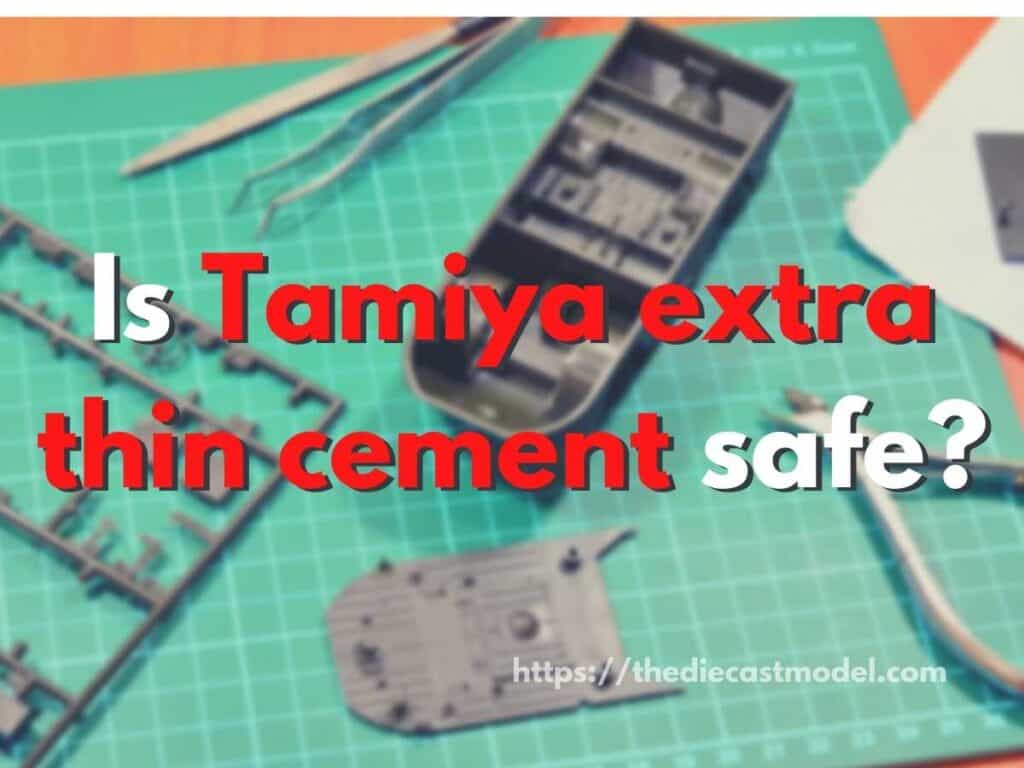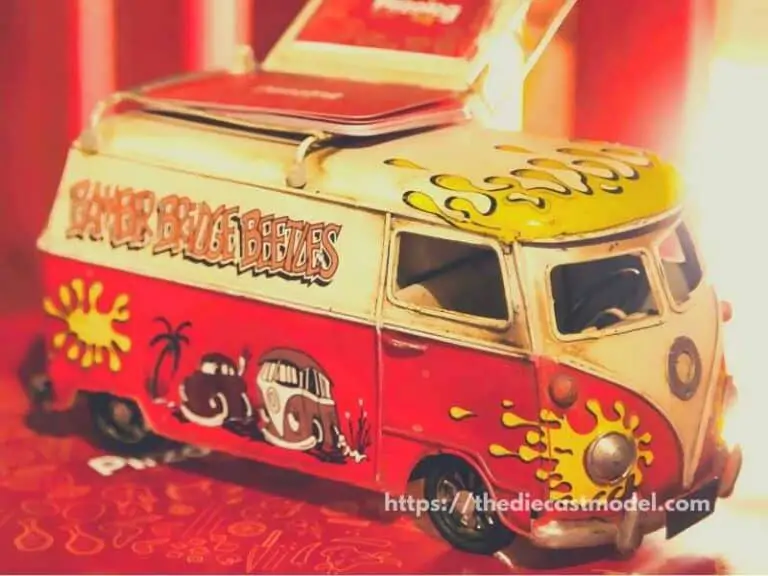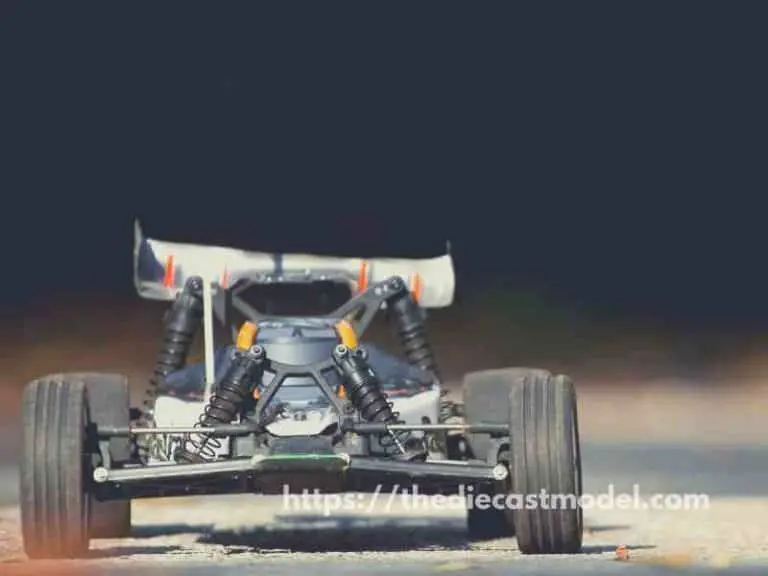Tamiya Extra Thin Cement: Is it Safe?
I know how good Tamiya extra thin cement is when it comes to the gluing process. It dries fast, is easy to remove, and provides a strong bond. However, we can’t forget the safety profile of the cement. Thus, here, I will answer if extra thin cement is safe.
Generally speaking, Tamiya extra thin cement is safe if used with precaution. However, extra thin cement emits a strong scent that can cause some mild irritations when breathing. Furthermore, extra thin cement is also flammable due to its components which means caution and proper ventilation are required.
In this blog post, we will talk about the safety profile of Tamiya’s extra thin cement. Furthermore, I will talk about some precautions when using the product and the safety profile of its ingredients.

Is Tamiya extra thin cement safe?
Tamiya Extra Thin cement emits a strong scent.
Liquid glues, such as the extra thin cement, can be safely utilized if the proper precautions are taken and the appropriate amount is applied.
Always proceed with caution when using Tamiya’s extra thin cement.
The most important rule is to ensure that you have enough ventilation because of the glue’s volatility and flammability.
When you are not gluing, make sure to keep the cap tightly sealed.
More so, because it will all evaporate in a matter of seconds!
Is plastic cement toxic?
Plastic cement can be toxic when exposed to high amounts due to its components. Too much exposure to plastic cement can produce irritations on the skin, nose, and throat. Furthermore, plastic cement has a pungent odor which can be uncomfortable if used without proper ventilation.
Plastic cement is usually made of Acetone and Butanone.
Both of these ingredients cause health hazards like difficulty in breathing.
Let’s discuss the effects of Acetone and Butanone below.
The Effects of Acetone in Health
Acetone is a colorless, highly flammable liquid chemical that can be either natural or synthetic.
Acetone has a distinct taste and smell that is often linked with nail polish remover.
Acetone quickly evaporates, which means it turns into a vapor.
Acetone quickly catches fire and burns rapidly. It can be dissolved in water.
Acetone enters the body via the lungs, mouth, or skin.
Acetone can also be found in the body as a result of fat breakdown.
Your blood carries acetone to all of your body’s organs.
Small acetone levels in your body are usually not harmful since your liver converts the acetone into other harmless molecules.
Acetone is safe to use in small amounts.
The nose, throat, lungs, and eyes might be irritated by breathing in moderate to high concentrations of acetone for a short period of time. [1]
Several other side effects include headaches and dizziness, a quicker heartbeat and vomiting, and a shorter menstrual cycle in women.
If you ingest a high concentration of acetone, you may get dizzy.
It can also harm your mouth’s skin.
Skin-to-skin contact can lead to skin injury.
Acetone has a pungent odor and can irritate the skin, so be on the lookout for these warning symptoms.
The strong, pungent odor can assist you in avoiding inhaling dangerously high concentrations of acetone.
The kidneys, liver, and nerves of animals exposed to acetone for long periods were shown to be harmed.
Birth abnormalities and male reproductive issues were among the other consequences.
There is no way to tell if these similar health issues would be present in human beings.
The Effects of Butanone in Health
Butanone, commonly known as methyl ethyl ketone (MEK), is a white liquid with a sweet yet astringent odor.
Because it evaporates quickly and dissolves a wide range of substances, butanone is produced in huge quantities to use in paints, glues, and other finishes.
Butanone will swiftly dissipate into the atmosphere. As a result, butanone is frequently found dissolved in water or as a gas in the atmosphere.
Butanone is a natural substance produced by some trees that you can find in some fruits and vegetables.
Car and truck exhausts emit 2-butanone into the atmosphere. As a result, butanone is commonly found in landfills and hazardous waste sites’ air, water, and soil.
People who inhaled butanone detected its sweet and strong odor at a concentration of 5-8 parts of butanone per million parts of air (5-8 ppm).
Mild irritation of the nose, throat, eyes, and skin has been observed in persons who breathed higher quantities of butanone. [2]
Only at extremely high doses of butanone have serious health problems in animals been observed.
These high quantities of butanone are not expected in our typical day scenario.
Animal studies have indicated that butanone does not cause substantial damage to the nervous system or the liver, but mice exposed to low doses for a short period of time saw transitory behavioral abnormalities.
Although butanone has no significant impact on the liver or nervous system, it can induce other chemicals to become more toxic to these systems.
Skin irritation occurred in rabbits and guinea pigs after low doses of butanone were applied to their skin.
Rabbits with small doses of butanone put in their eyes experienced severe eye discomfort.
It’s not clear if butanone causes birth abnormalities or interferes with reproduction in humans.
Animals exposed to butanone had no reproductive consequences.
What is Tamiya extra thin made of?
Generally speaking, Tamiya extra thin cement is made of butyl acetate and acetone. However, some extra thin cement contains other ingredients, such as ethyl acetate and butyl acetate, which are added to increase the setting speed of the adhesive.
Tamiya Extra Thin Cement is a well-known plastic cement among modelers worldwide. Moreover, it’s available in the majority of professional modeler’s workshops.
Tamiya extra thin cement comprises 50% Butyl Acetate, 50% Acetone, and other quick-setting ingredients such as 40% Ethyl Acetate, 40% Acetone, and 20% Butanone.
Ethyl acetate evaporates more quickly, but Butyl acetate is a hotter solvent on plastic.
Due to acetone and butanone properties, Tamiya extra thin cement takes only 10 seconds to set compared to regular plastic cement, which takes 2-3 minutes.
Acetone and butanone properties make plastic cement capable of melting plastic.
Final Words
Tamiya extra thin cement is safe to use if used with precautions.
Always store Tamiya plastic cement away from heat and ignition sources, as well as incompatible items, in a cool, dry, ventilated place.
Remember that acetone is highly volatile and flammable.
Close the jar tightly and store it safely.
Food, alcohol, and animal consumables should be avoided while using the product.
Did you know? Did you know that isopropyl alcohol can be used to remove paint from models? Rubbing alcohol is effective and safe for plastics. If you want some tips on how to use isopropyl alcohol to level up your painting skill, feel free to check this post: Does Isopropyl alcohol damage plastics?
When this material’s bottles are emptied, they still may pose a hazard.
All the danger precautions outlined must be followed because emptied bottles still contain product leftovers (vapor, liquid, or solid).
It would be best if you did not inhale this product’s vapors or mists.
The glue should not come into touch with your eyes or skin. Please use some gloves when applying the glue, as acetone can dry your skin.
After using the cement, hands and other exposed areas should be thoroughly cleaned with soap and water, especially before eating and drinking.
What’s next? One of the things you might ask is if Tamiya’s extra thin cement works on clear parts. Since many types of glue tend to cause fogging, you might need to know some extra precautions on applying extra thin cement. You may find the blog post here: Does Tamiya Cement Work on Clear Parts?

“Only the things I love”
thediecastmodel.com is reader-supported. When you buy through links on the site, I earn an affiliate commission.
So, here are the things I love when taking care of my Diecast Models.
Cleaning the Models
The first we are going to talk about is cleaning the models.
Removing Dust
- Air Brush – For me, this is the best since it not just removes dust but you can use it in painting/clear coating.
- Air Duster – This is a good alternative to Airbrush
- Normal Brush – If you are short on budget, you can use a normal brush. However, make sure that the brush has soft bristles because there are some hard brushes than can cause scratches. That’s why I recommended a good brush that can do the job properly.
Cleaning and Shining Hacks
Well, here are some of my cleaning hacks for removing scratches, oxidation, and so much more.
- Removing Decal Adhesive – Use Goo Gone on those hard-to-remove decal adhesives. It works fast and works like charm!
- Waxing and Polishing – Here is something a lot of people don’t know. Waxing protects the clear coat and paint while polishing shines the model. Instead of buying it separately, use a 2 in 1 to save money. Get this instead.
- Beginner Wax – The wax I recommended earlier is good and provides the best results based on my experience. But a beginner might have a problem especially if they’re not good at applying wax. Solid wax reaching hard to reach surface can be hard to remove. You have two choices here. One is to use a qtips to reach those surfaces, another is to use a liquid wax I recommended.
- Cleaning Wheels, Rubber, Plastic – Do not forget that rubber and plastic surface are quite different, especially in the cleaning process. Just wiping it down won’t do the job. That’s why I use Meguiar’s Vinyl and Rubber Cleaner and Conditioner. Works like charm!
- Make the Wheels Shine! – Making our models look good won’t be complete without tiny details such as shiny wheels! Do not forget this because however small this is, the difference can be as big as night and day.
- Remove Scratches Easily – Tiny scratches are not the end for your model. Here is a simple trick I’ve been using to make my models look scratch-free even without repainting. Use T-Cut.
Painting the Models
Painting Tools
Make sure when you paint models, have these ready.
- Tape – A tape is important if you are painting a straight line. Furthermore, it will prevent your paint to scatter on other parts. I recommend Tamiya Tape since it is really made for models. Furthermore, they stick really well preventing paint splatters.
- Brush (Beginner) – Find a good set of brushes to paint your models. Of course, you can opt for an airbrush but it’s quite expensive.
- Airbrush (Intermediate/Expert) – This will yield a significantly better result than an ordinary brush because you can easily spray the paint evenly. I recommend this if you know what you’re doing.
- Stand(Optional) – Stands are good because it can be hard to manually hold the models while painting. It is optional but in my opinion, the price is well worth it for the comfort it gives.
- Drop Cloths – Drop Cloths will protect your surroundings from the paint.
- Primer – The most common beginner mistake I see is painting models without any Primer. A primer will prevent imperfections such as bubbles or paint not sticking to your models. It is a small price to pay for quality results.
- Clear Coat – A clear coat will protect the paint of your models. This will make the paint last longer. Also, it is the one responsible for making your models shine.
Paints
Of course, you can’t do painting properly without paint. So here are the ones I recommend.
- Acrylic Paint – Good for beginners because it dries quickly. However, it doesn’t produce results as good as enamel paint.
- Enamel Paint – Provides a good quality finish and longer-lasting paint. However, it takes longer to dry and requires expertise to use.
Model Maintenance
Model Storage
- Simple Wood Cabinet – While it doesn’t let you display your models, wooden cabinets are good storage for these models. For one, they are not heat conductors which means that the temperature inside will remain constant and remain cool. Furthermore, they prevent light from reaching the models which can cause oxidation.
- Clear Cabinet with Lock – If you want to display your models, then I recommend this. It closes so dust won’t easily get to your models. I also recommend you don’t put more than 1 model in each compartment since metals are good conductors of heat.
Model Photography
So you want to show off your models to others? Well, I got you covered.
Here is my beginner-friendly model photography tutorial that teaches everything from taking pictures to the editing process.
You will also see me doing hands-on photography in that tutorial.
Here is the link: How to Take Pictures of a Diecast Model or Model Kit | Helpful Illustrated and Video Guide
Source







